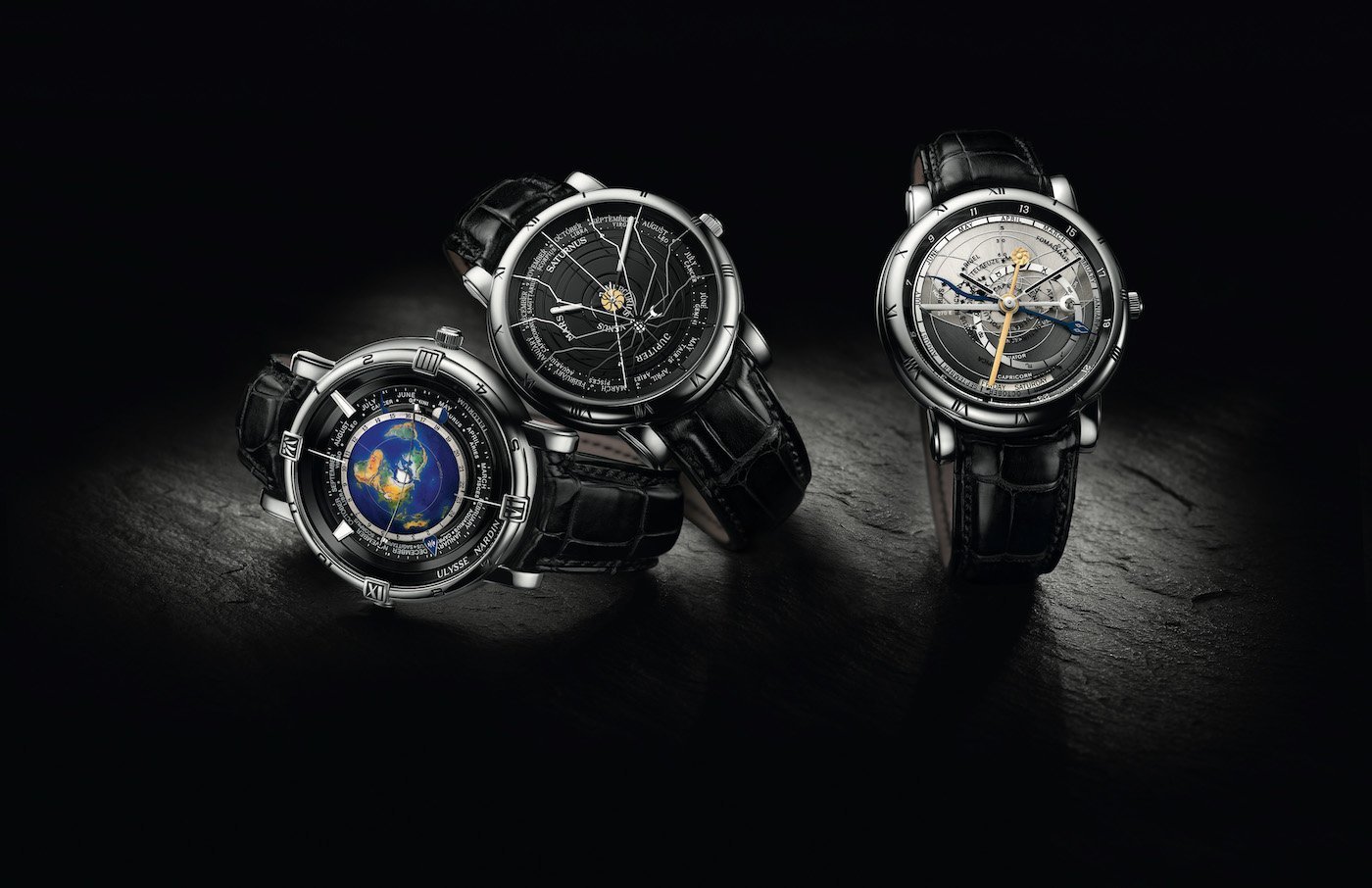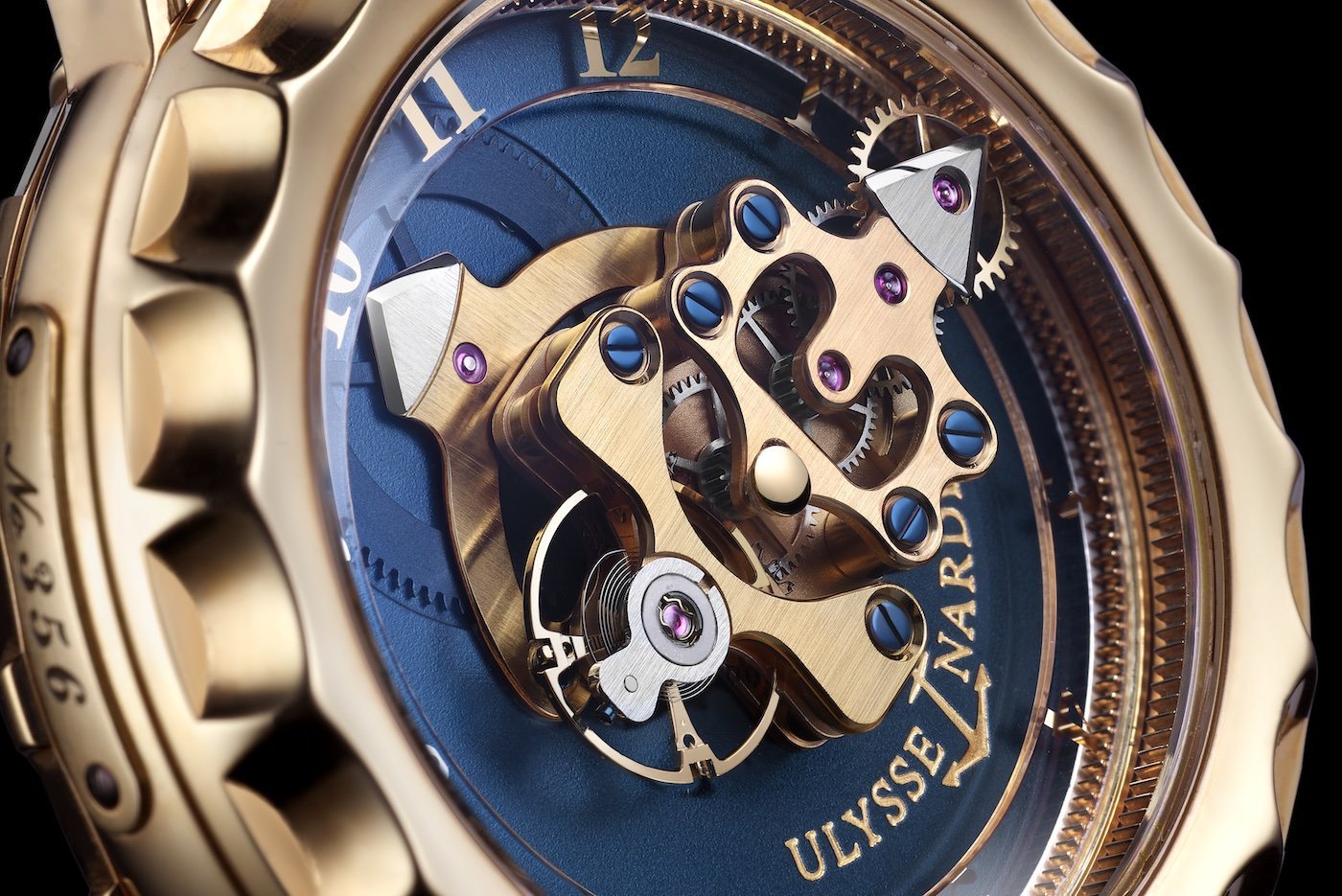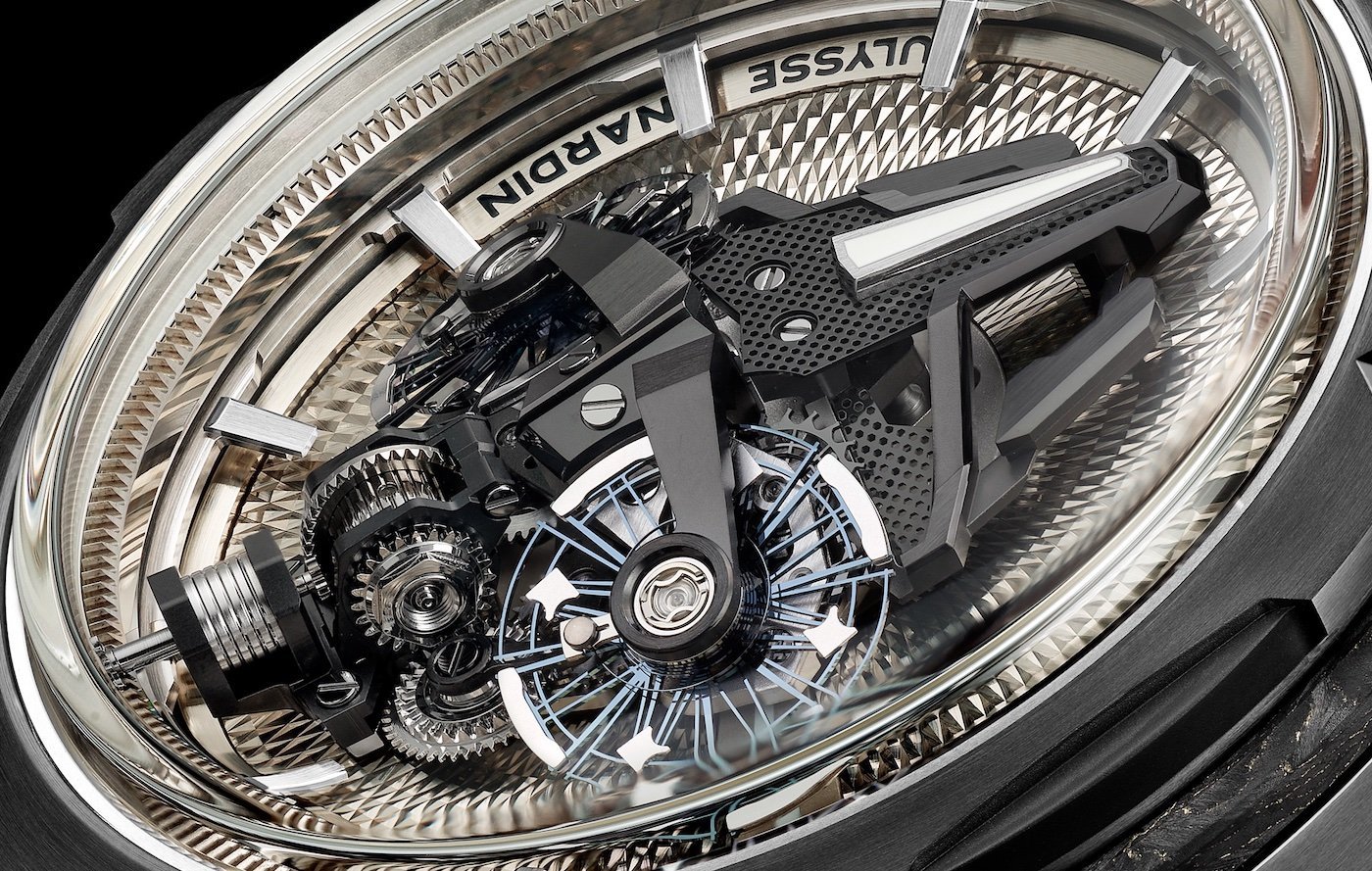n the morning we met, Ludwig Oechslin was wearing a beret with the peculiar addition of a small mirror, no more than a centimetre square, pinned to the right side. “In daylight, people who are bothering me get the full glare,” he explained, a glint in his eye. There are so many surprising sides to this polymath, starting with his passion for the mechanical.
Nothing destined Ludwig Oechslin to horology, apart from his endlessly enquiring mind. Having graduated in 1978 in archaeology, Greek and Latin from the University of Basel, he considered his options. Academic life was not for him. What he needed, in his words, was to “find a job that paid money.” In Lucerne, his constant badgering earned him an apprenticeship with master watchmaker Jörg Spöring – something that astonishes him to this day: “Taking on a 24-year-old graduate with no technical background whatsoever was pretty uncommon.” He continued his studies at the same time.
-

- Dr. Ludwig Oechslin
His apprenticeship lasted for six years, three of which he spent in Rome, at the Vatican, where he dismantled, studied, restored and reassembled the Farnese Clock; a remarkable astronomical clock that was commissioned in 1725 by Dorothea Farnese von Pfalz-Neuburg, the Duchess of Parma and Piacenza. “It’s an extraordinary clock,” says Oechslin. “Highly complicated with epicyclic gears on multiple levels. It’s amazing to think that Bernardo Facini, who built the clock, didn’t have all the mathematical tools he needed to calculate the gears.”
-

- The astronomical clock built by Bernardo Facini in the first half of the 18th century for Dorothea Farnese von Pfalz-Neuburg, the Duchess of Parma and Piacenza, and restored in the early 1980s by Ludwig Oechslin.
Ludwig Oechslin recorded in detail every one of the more than 1,000 pieces in the clock’s mechanism. He was beginning to make a name in the (small) world of timepiece restoration when he met Rolf Schnyder, the then owner of Ulysse Nardin. The two men struck up a friendship that would span several decades of shared creativity. The rest is watchmaking history. Here is our interview with Dr. Oechslin.
Europa Star: In 2001, six years after you were awarded the Prix Gaïa, you were made Curator and Director of the Musée International d’Horlogerie (MIH) in La Chaux-de-Fonds. In an interview with Le Temps, you said that “First and foremost I intend to collect objects with a story attached to them. A watch will be shown alongside an interview with the person who restored it. It’s my intention to analyse the social history behind the objects.” How did your appointment at the MIH come about?
Dr. Ludwig Oechslin: I was planning to move to Italy, to look for a job as curator at one or other museum, when the MIH got in touch. I had the privilege of being chosen among several highly talented candidates and to take over from the then director, Mrs. [Catherine] Cardinal. I subsequently ended my collaboration with Ulysse Nardin, but maintained excellent relations with its owner, Rolf Schnyder.
-

- The philosophy of Ludwig Oechslin at Ulysse Nardin, from a 1996 issue of Europa Star.
- ©Archives Europa Star
You’re the creator of an unusual in-line calendar for the MIH. Speaking with Pierre Maillard in 2017, you declared that “I wanted to make a genuinely useful watch, with a calendar function that put the day, date and month on a single line. This could only be found on Patek Philippe pocket watches. I had to find a solution that would allow it to be big and highly readable. I moved the line to the side, because it wasn’t possible to have it in the centre. And that is how my annual calendar was born.” What’s your memory of this project?
I was always very creative, searching for ways to improve my ideas. One development fuelled another. For example, in 1984 I began research into a new perpetual calendar that would finally be released for the 150th anniversary of Ulysse Nardin in 1995. Rolf Schnyder was extremely gracious in naming it the “Ludwig”. I began by imagining someone taking an eye test, who had to read rows of increasingly large capital letters. I tried the same thing with conventional displays by means of hands and realised this wasn’t the most easily legible solution. The only truly effective solution, including when viewed from a distance, is to show indications by means of discs through apertures. This led me to develop the Ludwig perpetual calendar.
-

- The origins of the Ulysse Nardin Astrolabium Galileo Galilei in a 1985 issue of Europa Star.
- ©Archives Europa Star
The 1990s were a period of intense creativity at Ulysse Nardin, with the Perpetual Ludwig, the Sonata and the Freak, and the Trilogy of Time prior to that. For more than twenty years you worked exclusively for Ulysse Nardin. Tell us about your relations with Rolf Schnyder.
I met Rolf Schnyder when I was still a young apprentice watchmaker under my master, Jörg Spöring. During one of his frequent visits, Schnyder asked if it would be possible to miniaturise the astrolabe clock we were working on. The Astrolabium watch incorporates a mechanism that requires adjustment once every 144,000 years.

After this initial project, I devised the Planetarium and the Tellurium which completed the “Trilogy of Time”. From there, I developed the perpetual calendar that bears my name, adjustable forwards and backwards, followed by the high-precision Sonata alarm watch and then, in 2001, the Freak. Rolf Schnyder had acquired the concept for a rotating movement which, unfortunately, didn’t work. I wanted to help him out by designing one that would work! The rotating movement gave me the idea for hourly rotations which could display the minutes. Everything in this watch forms a whole: energy, gears, escapement, indication and the silicon itself, as a material. It’s a fantastic jumping-off point for the team at Ulysse Nardin. Enough to build projects and introduce developments for twenty, maybe thirty years to come!

In 2010 you told the journalist Elizabeth Doerr that “I think that Jost Bürgi* was (...) a figure from which one can start out again and again. When you look at him in total, he was probably one of the most innovative watchmakers of all time.” What is it about Jost Bürgi you find so fascinating?
Jost Bürgi was a watchmaker, a mathematician and an astronomer. Can you imagine! He achieved unbelievable precision thanks to mathematical tools which he conceptualised himself. He was employed at the court of Emperor Rudolf II where apparently he was paid more than astronomers Johannes Kepler and Tycho Brahe. He didn’t write Latin so unfortunately none of his research has been passed down to us. I feel close to him and to his many reflections on astronomy, mathematics and mechanisms.
-

- The Wiener Kristall-Globusuhr (Viennese Crystal Clock), built by Jost Bürgi for Emperor Ferdinand II. The mathematician and clockmaker is believed to have devoted the last years of his life to the making of this astronomical complication. Considered his masterwork, it is now on display at the Kunsthistorisches Museum in Vienna, Austria.
You’re a firm believer that “less is more”, as told to Pierre Maillard in the same 2017 interview: “In my view, functionality is more important than beauty or the number of parts.” Is there a practical limit to how far one can simplify a mechanism?
I would say – quite simply – that the size of a wristwatch sets numerous limits for movement developers. Hence the need to reduce the number of components.
-

- Ulysse Nardin Freak 02, ref. 026-88 (2005). Second version of this revolutionary watch, which debuted in 2001. The hours are shown by the triangular tip of the in-line movement – a first in watchmaking. The Ulysse Nardin Dual Direct Escapement is in silicon, an innovative material at that time, and functions without lubrication. There is no crown. The time is set by the rotating bezel and the mainspring is wound by the case back.
You’ve worked with Ulysse Nardin on another iteration of the Freak this year, the Freak S Nomad. What does it represent for you?
This watch is really about being fun for the wearer. It’s the exact opposite of traditional, static watchmaking. It’s also simplified to the extreme, having neither hands, nor dial nor a crown. Having studied the Farnese Clock and its gears, I was able to materialise a movement mounted on a carousel that completes one rotation per hour. The new escapement in silicon, which reduces friction, is completely symmetrical, with two gears giving the same impulse to a tiny central part. It’s all epicycloidal. The movement is wound at the back of the case and the time is set from the front, by the bezel.
-

- The Ulysse Nardin Freak S Nomad (2024) is the latest Freak to date. Housed inside a 45mm titanium case, the in-line movement’s two inclined escapements, linked by a differential system, form a futuristic architecture evocative of Star Wars or Star Trek, while the hand-executed sand-coloured diamond guilloché pattern is pure tradition.
What are you currently working on?
Right now I’m focusing on clocks. I buy them – one of my most recent purchases is a beautiful Detouche – and I also develop new ones. But my true passion is still astronomy.

BIOGRAPHY
1952 Born in Gabicce Mare, Italy.
1977 Bachelor in archaeology and the history of ancient Greek and Latin from University of Basel.
1976-1984 Watchmaking apprenticeship under Jörg Spöring.
1981 Conceptualisation and construction with Jörg Spöring of an astronomical clock with astrolabe.
1983 At Jörg Spöring, met Rolf Schnyder (1935-2011), new owner of Ulysse Nardin in Le Locle, who suggested adapting the astrolabe clock as a wristwatch.
1983 PhD in philosophy, theoretical physics and astronomy
1984 Qualified as a watchmaker-repairer.
1985 Astrolabium Galileo Galilei watch for Ulysse Nardin.
1988 Planetarium Copernicus watch for Ulysse Nardin.
1992 Tellurium Johannes Kepler watch for Ulysse Nardin.
1993 Qualified as a master watchmaker.
1995 Habilitation in preindustrial archaeological technique at the Swiss Federal Institute of Technology in Zürich (ETHZ) for his thesis on astronomer-priests. Prix Gaïa with Michel Parmigiani and Antoine Simonin.
1996 Perpetual Ludwig watch for Ulysse Nardin. Sonata watch.
2001 First Freak watch for Ulysse Nardin.
2001-2014 Curator and Director of the Musée International d’Horlogerie (MIH) in La Chaux-de-Fonds.
2006 Launched ochs und junior in association with Beat Weinmann and Kurt König.
2024 Freak S Nomad watch, limited to 99 pieces.
*Self-taught and, for many, the inventor of the seconds hand, Jost Bürgi (1552-1632) knew Tycho Brahe and worked with the astronomer Johannes Kepler at the court of Emperor Rudolf II in Prague. Shortly before that, in Kassel in 1592, he presented the first celestial globe to be acknowledged for its precision. It reprised early work by Copernicus and his heliocentric model. Bürgi demonstrated the full extent of his understanding of astronomical phenomena in six terrestrial globes, built in Prague. One, now on display at the Landesmuseum Zürich, mechanically tracks the movement of over 1,000 stars.


























































